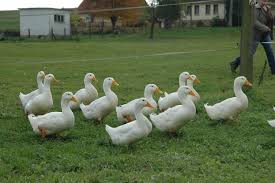 |
| Today’s Pekin Ducks |
The first domesticated ducks reached our shores from China in the late 1800s. And by our shores, I do mean our Long Island. In 1874, one James Palmer of Stonington CT imported the first Pekin Ducks. The ducks became so numerous on the Island, that they were called Long Island ducks. To this day, the Pekin or Long Island Duckling is the most common of all ducks, making up about 95 percent of the duck Americans eat. In China, they were bred from Mallards. The ancestors of today’s Pekin Ducks lived in the canals of Nanjing. They had small bodies and black feathers. When the Chinese moved their capital to Beijing (Pekin), barge traffic increased. These barges would often spill grain into the canals and the ducks ate it up. They slowly increased in size, grew white feathers and became Pekin Ducks.
 The Long Island ducks prospered in their new home. And they formed a great part of the local economy. By 1939, there were about 90 duck farms almost all of them concentrated in the towns of Eastport, Flanders and Riverhead. When I first came to Bridgehampton, there was a sizeable duck farm in the next town over, Water Mill. Most of what I remember of that farm was the stench. Over the years, as property values rose stratospherically on the East End of Long Island, and concerns about water pollution rose too—that stench I told you about–the duck farms all but disappeared. Indiana and Wisconsin have long surpassed Long Island in production although 10 percent of duck consumed in this country is still from L.I. A local monument to the Long
The Long Island ducks prospered in their new home. And they formed a great part of the local economy. By 1939, there were about 90 duck farms almost all of them concentrated in the towns of Eastport, Flanders and Riverhead. When I first came to Bridgehampton, there was a sizeable duck farm in the next town over, Water Mill. Most of what I remember of that farm was the stench. Over the years, as property values rose stratospherically on the East End of Long Island, and concerns about water pollution rose too—that stench I told you about–the duck farms all but disappeared. Indiana and Wisconsin have long surpassed Long Island in production although 10 percent of duck consumed in this country is still from L.I. A local monument to the Long
Island duck, the Big Duck, is a constant reminder of Long Island’s history of duck farming. The Big Duck is a building in the shape of a duck that was constructed in 1931. Duck Farmer, Martin Maurer used it as a shop to sell his ducks and duck eggs. The Duck measures 18 feet wide, 30 feet long and it’s 20 feet tall to the top of its head. Unfortunately, in 1984 its days of selling ducks were over. So well known, Suffolk County bought The Big Duck and moved it to the main road between the Hamptons and Riverhead in 1988. But the Duck moved back to its original location where it still sits operating as a Tourist information and gift shop.
1. Position a rack in the center of the oven and heat the oven to 350°F. Season the duck legs all over with 1/2 tsp. salt and 1/4 tsp. pepper.
2. Return the skillet to the stove, add the wine, and scrape up any browned bits on the bottom of the pan. Boil until reduced by half, 1 to 2 minutes. Add 1/2 cup of the dried fruit, the garlic, thyme, and red pepper flakes.
3. Return the legs to the skillet skin side up and carefully pour enough broth around the legs to come about 2/3 of the way up the sides. Bring to a simmer, transfer to the oven, and braise, adding more broth if necessary to maintain the level, until the meat is fork tender, about 1-1/2 hours.
4. Season to taste with salt, pepper, and additional lemon juice. Serve the duck with the sauce, topped with the remaining parsley.


















